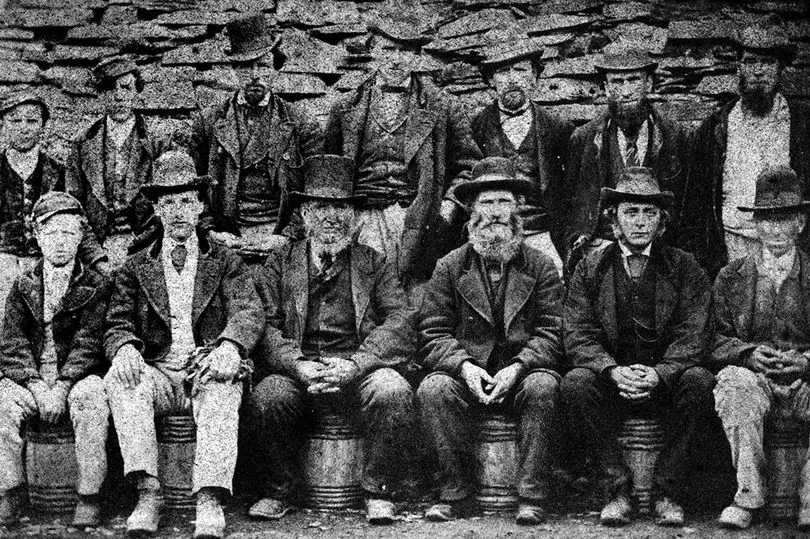HIDDEN photographs found gathering dust in a Llanberis attic for more than 100 years have prompted an ongoing detective story into lives from the past.
A treasure trove of images, glass photographic plates, prints, letters and other pieces of paperwork were discovered when a family moved into a home on Thomas Street back in the 1980s.
The material was the work of Isaac Hughes – the first photographer to live in Llanberis.
He also built a row of houses in the town as he grew in prosperity.
Hughes took hundreds of images and portraits of villagers, and also captured images of the slate quarrymen at the Dinorwic Quarry.
The images cast a tantalising glimpse into the stories of people who lived in and around the Llanberis area between the 1870s and 1880s.
The pictures are being displayed at St Padarn Church, on Tuesday, January 9.
It follows a previous exhibition, commissioned just before the first lockdown.
Ongoing investigations have seen researchers painstakingly restore faded images and delve into archives and records uncovering the stories of local people and of the charismatic photographer.
It is hoped the latest show might prompt local people to dig out more pictures of their ancestors taken by Hughes.
Gareth Roberts, co-ordinator of ‘The Menter Fachwen Walk and Discover Project’, said the photographer was also widely known across North Wales, spending time on Anglesey, as well as in the north of England.
It is believed he learned his craft in Liverpool.
“It has become quite the detective story finding out about Isaac Hughes, and piecing information together about who the people are and where the pictures are taken,” said Mr Roberts.
“Lockdown gave me the chance to do more of the time consuming work restoring the plates and images, studying the census returns and documents.
“We know Isaac Hughes was born in 1833, he came from humble origins, and lived with his family on a farm at Dyserth.
Although he had based his life for some time in Llanberis, he would return to Dyserth in his later years.
“He died aged 78 in 1911 and was buried with his parents there.
“A man had wrote in the 1920s about his childhood in Llanberis, and described seeing Isaac, describing his ‘unique beard’ at the time.
“He was a real character, and what comes out in people’s recorded memories is what fun people had with him.
“He travelled everywhere in his horse drawn studio, we know he spent some time on Anglesey, and he was known as an excellent horseman.
“On one occasion, he left his studio near Benllech, he had taken his horses away for some reason, but the police deemed the cart was causing an obstruction and he was fined five shillings.”
Mr Roberts has studied the images deeply to establish where they were taken, with one picture showing two quarry men shaking hands on “a bargain”.
“It was a set up scene, the glass plate was so damaged that I didn’t bother to do much restoration on it,” he said.
“However, when I worked on the contrast, I noticed the name ‘Abyssinia’ written in chalk on a piece of slate behind the knee of the guy on the left.
“I realised this was taken at the cutting shed at Abyssinia gallery of the Dinorwic Quarry.”
In another image, he found that Isaac Hughes had written ‘Elizabeth Hughes. 4 months old. 8th August 1878’ on the back.
“From this I was able to track her life story. She lived in Pentre Castell, Llanberis,” Mr Roberts said.
“Her father was killed in the quarry when she was eight.
“She married a quarryman when she was 22 and her husband was also killed in the quarry a short while later. I lost track of her then in the records.”
In one image, men and boys appear to be seen sitting on barrels of gunpowder.
“They are either very brave or stupid! We know they are full as ropes around the barrels are still intact,” Mr Roberts said.
“The young boys in the photo would have had the task of carrying the barrels from one part of the quarry to another.”
Another image taken in Isaac Hughes’ gallery post 1880 shows a stern looking man.
“The photographic glass plate was very damaged and it took me a week to restore the image,” Mr Roberts said.
“By pure luck, I came across a photograph of the same man taken 20 years later by another photographer, it was Richard Hughes, a chemist and a lay preacher at the chapel that Isaac Hughes often attended when he lived in Llanberis.” he said.
He was known locally as ‘Hughes Drygist (Druggist)’.
The bridge over Afon Goch in Llanberis is still known as ‘Pont Hughes Drygist’ to this day, as he lived in a house next to the bridge.
Sometimes there are clues in the photograph as to people’s identity, Mr Roberts said.
A basket of books by a man in one portrait suggested the image could be the Llanberis bookseller, Daniel Williams.
Mr Roberts said: “The man fits a description of him. Williams was also an agent, arranging travel for people emigrating to America.” One photograph in the exhibition is thought to be that of Isaac Hughes himself, taken by his brother H.J.Hughes, using some of Isaac’s photographic ‘props’ which turn up in many of his portraits and help identify his images.
Mr Roberts added: “We’d love to know more about Hughes, or if anyone out there who can shed light or family memories on any of the photos.
“We are also appealing for people to bring in any Isaac Hughes photographs they might have.
“He had a big impact on Llanberis, he built a row of houses there on Thomas Street, and had his own lean to gallery.
“There must be lots of pictures still stashed away in tins in attics and cupboards in the area and much further afield, he took photographs across North Wales and more than likely as far away as Liverpool.”
Isaac would often stamp the back of his pictures with “I Hughes or Isaac Hughes”.
The exhibition is open between 10am and 2pm Mondays to Fridays and admission is free.



















